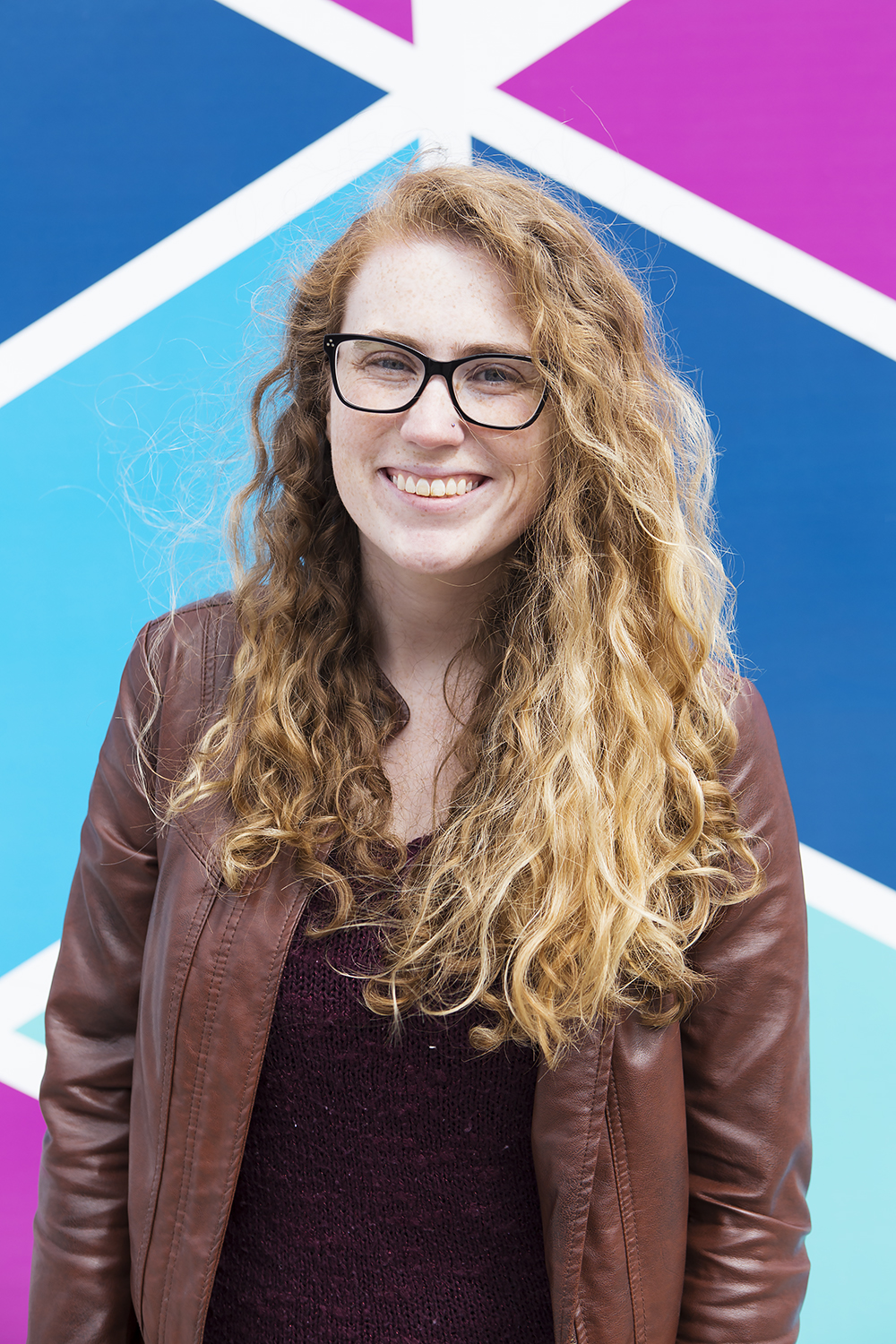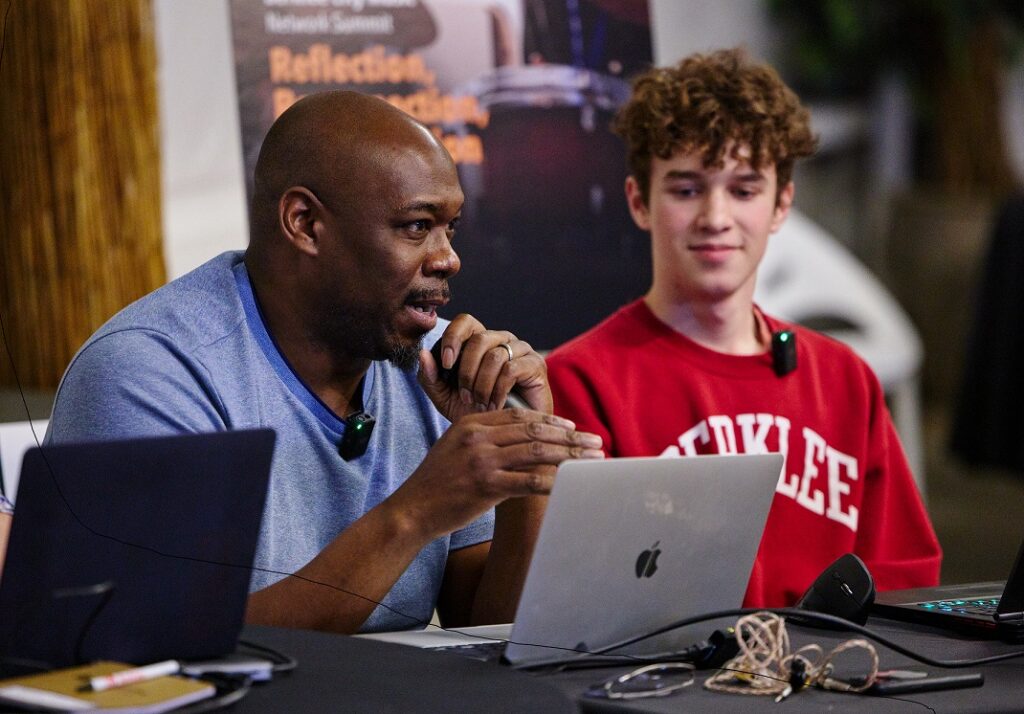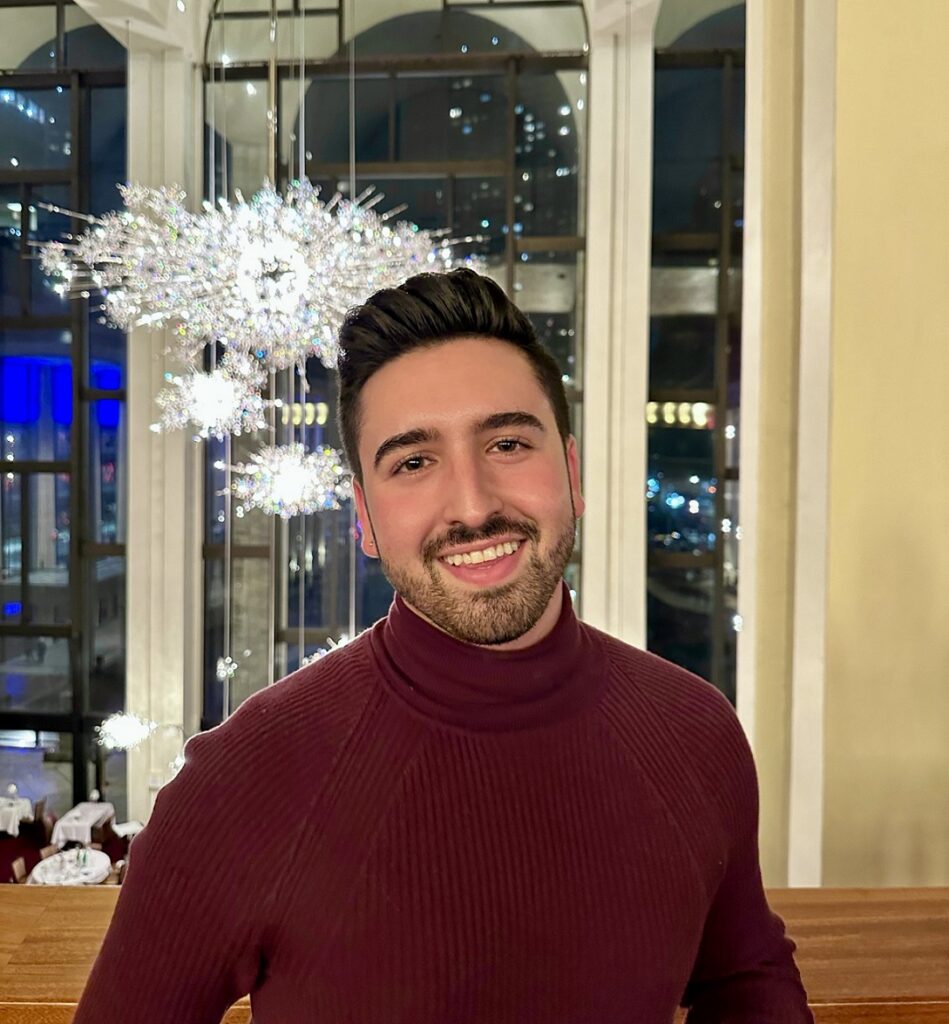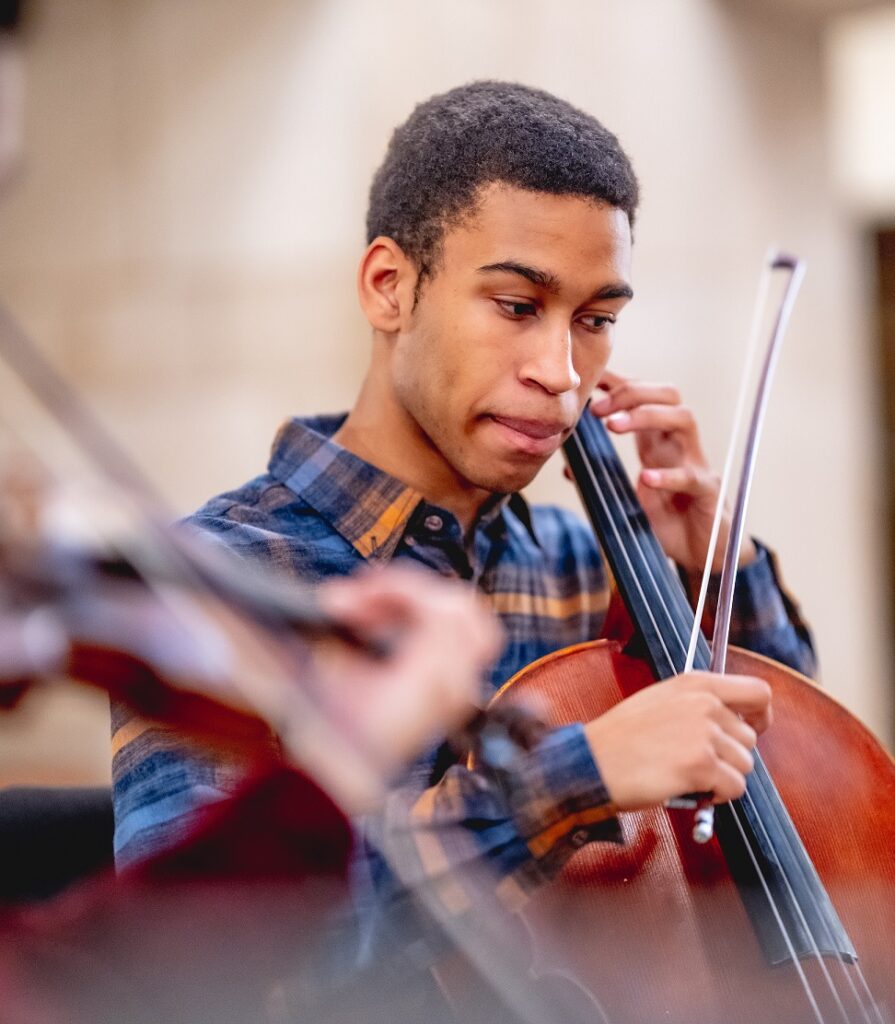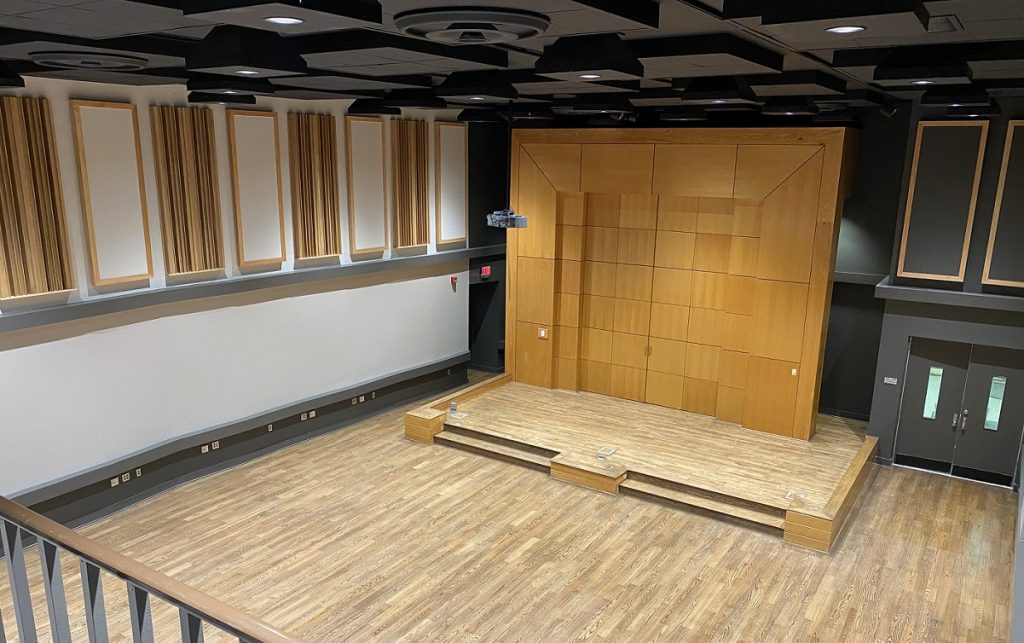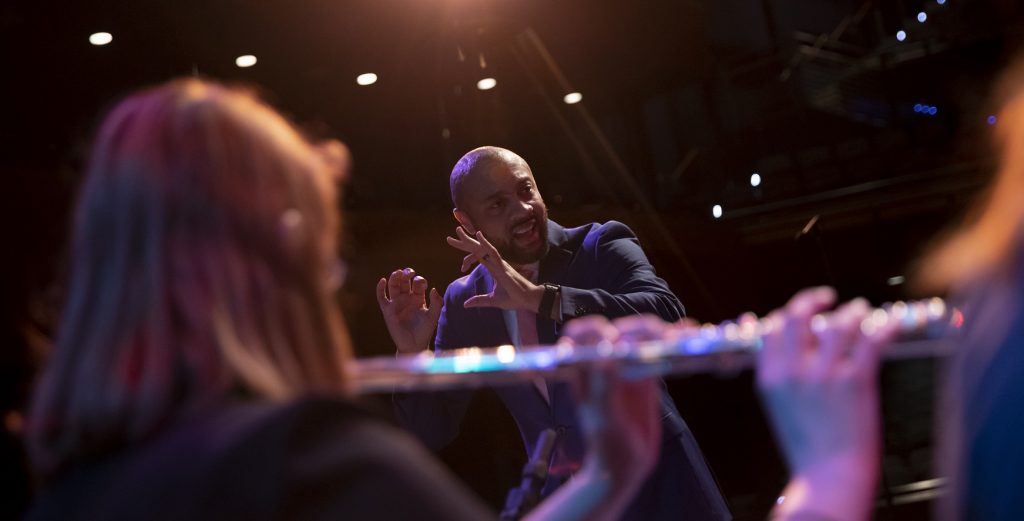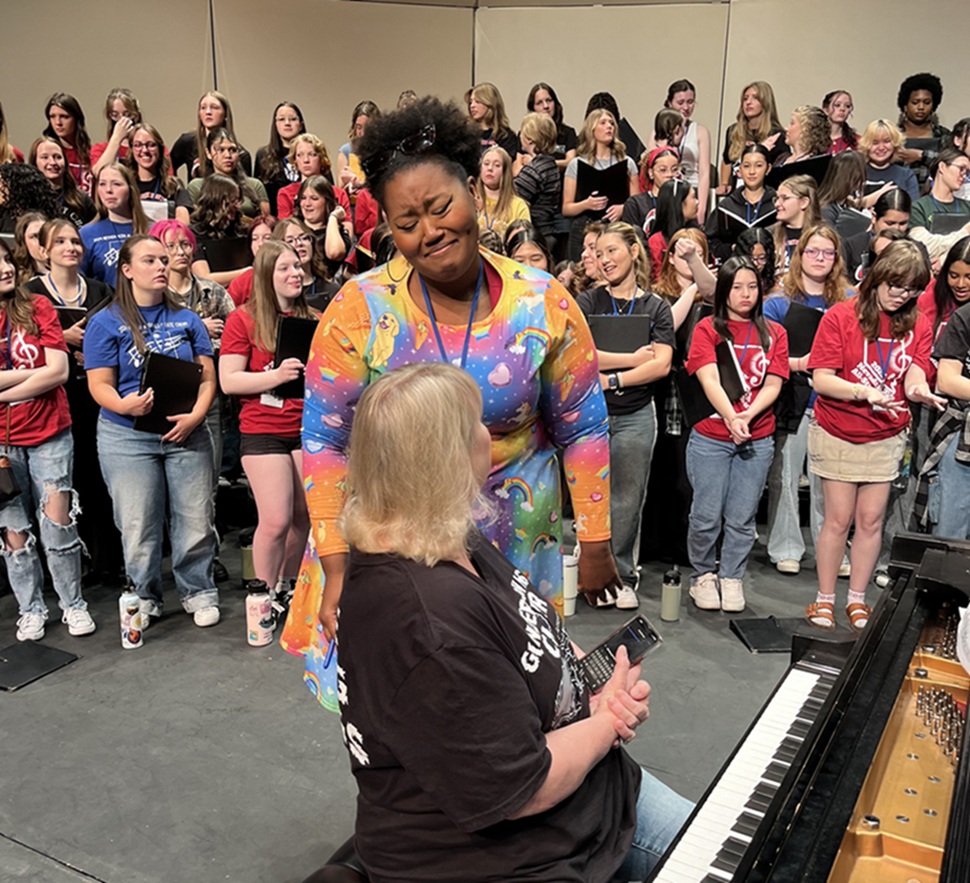Tagged Under:
How DEI Initiatives Influenced UK’s Music Education Program
An associate professor at the University of Kentucky fully integrated DEI elements into the music education program after looking at ways that her students could better relate to each other as well as to their future students.
When Dr. Martina Vasil, associate professor of music education at the University of Kentucky, attended the 2019 American Orff-Schulwerk Association Professional Development Conference, she discovered a new way to level up her instruction beyond repertoire. At this conference, Vasil met Dr. Nicole R. Robinson, former vice president for equity and diversity at the University of Utah, who had just started her own business: an online learning platform called Cultural Connections by Design.
“Dr. Robinson led an activity where we identified all the privileges and lack of privileges we have, all these different facets of people’s identities,” Vasil says. “It was eye-opening for me. Growing up poor [and with] immigrant parents, I never felt disadvantaged because of the power of being white [and] having English as a first language.”
This activity inspired Vasil to think about the ways that her music ed students could analyze their own backgrounds to better relate to one another — and to their future students. “A lot of students don’t realize that if you’re white, if you’re a man or if English is your first language, you immediately have an advantage,” she says.
Vasil then contacted Robinson, who directed her to the Cultural Connections website, where her students could test out a new course she was developing. While Cultural Connections had begun as a resource for businesses and consulting, Robinson wanted to expand the audience to college students. Vasil brought her students onto the platform as a test group, where they completed online modules about implicit biases, microaggressions and other key elements of diversity, equity and inclusion (DEI) work.
Initiatives like these have been part of an overall emphasis on DEI within the school of music at the University of Kentucky. Vasil has been teaming up with her colleagues and graduate students to integrate DEI education in the music classroom.
For Vasil, a big part of DEI comes from collaboration with other educators. In addition to her work with Robinson and Cultural Connections, Vasil regularly seeks guest speakers to give her students the best DEI education possible.
The Equity Epiphany
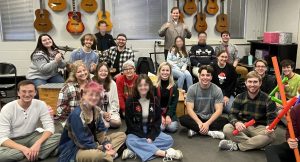
Though faculty at the University of Kentucky always understood the importance of DEI, mid-2020 was when Vasil and other faculty members embraced its immediacy. “When George Floyd [was] murdered, [we] began grappling with how much we didn’t know and how uneducated we were on non-white experiences,” Vasil says. “Kentucky is a very white state, but we do have diversity on campus … we looked at our curriculum and realized that it needed updates.”
One of Vasil’s responsibilities is to prepare future music educators for their teaching careers. When a music teacher enters an elementary school music classroom, that classroom will comprise all students in that grade; therefore, elementary music teachers must understand the experiences of students from a range of backgrounds. “I asked area K-12 teachers what they wished our students were better prepared to do,” Vasil says.
She also worked alongside her graduate students to find ways to incorporate their specialized areas of research into an overall education. “I had a student who did a whole thesis on multi-language learners because we have an increasing population of these students in Kentucky,” she says.
For Vasil, who considers herself a practical educator, learning about DEI was a journey in thinking outside the box. While she used to focus on “the main approaches to teaching” and “the practical approaches of what you need in your toolkit,” she has now shifted her attention to spending more time talking about how to best teach diverse student populations.
Because Vasil’s students are planning to become educators themselves, they can perpetuate this message in their own careers. “I never had that training in my undergrad, and you repeat what you’re taught,” she says.
Inclusion on the Internet
After connecting with Robinson, Vasil saw an opportunity for her students to learn using the Cultural Connections by Design online program. “[Dr. Robinson] let us access the program for free for a month in exchange for being her beta testing group,” Vasil says.
Vasil gave her students a month to complete the online course, which contained about five hours’ worth of material, including video lectures and follow-up questions like, “What is bias?” and “What’s unconscious bias?” as well as open-ended questions about how students might react in certain situations.
Because Robinson is planning to release this course — the first Cultural Connections course aimed at education institutions rather than companies — Vasil is hoping to use it for future classes as well. “It’s my plan this spring to ask my director if everyone can do the training,” she says.
Vasil found the course helpful for current educators and students alike. “Some of the terminology I had heard before, but some were new for me,” she says. “Understanding the terms and some applications and scenarios were very helpful.”
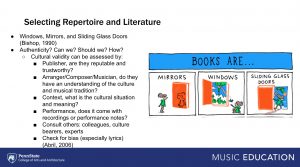
Adding a course to specifically address DEI can be important, but it’s not the only approach an educator can take. Vasil is also finding ways to bring DEI lessons into the music classroom itself.
Culture in the Classroom
The world of music is diverse, from the varied instruments and genres to the countless composers and performers. One place that educators can celebrate diversity in music is through their repertoire choices. “Our whole school of music has been much more focused on repertoire by making sure there are more female composers and composers of color,” Vasil says.
Even outside of ensemble performance, diversity is an important topic for future music educators to learn. For example, an educator may enter a school where most students don’t speak English, which requires tailoring the lessons to include more visual images rather than solely verbal instruction.
On Fridays, Vasil’s students visit local elementary schools for observation and student teaching. “Three of my students were at a school with a very high Japanese population [which includes multi-language learners],” Vasil says. “When they’re designing their lessons [for] multi-language learners, [they] use more icons or visual pieces.”
Don’t Blindly Accept Common Folk Songs
Even simple nursery rhymes or childhood songs that educators choose can have historical implications for various demographics. For the past two years, Vasil has been following a page on social media called Decolonizing the Music Classroom. This page and its accompanying website detail the ways that music educators can consciously choose songs that are free from a racist history.
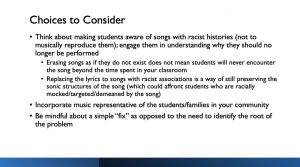
For example, the song “Jim Along Josie,” which is often taught to young children, was first sung by a performer in blackface during a minstrel show. “The original words are meant to mock the way African Americans spoke,” Vasil says. “It gets forgotten after 40, 50, 60 years … I have students who have never heard of minstrel shows.”
In these cases, it’s important for future educators to have conversations about certain songs’ history and their racial implications. Often, the best choice may be to not to use those songs in an elementary classroom.
Though “My Old Kentucky Home” is a common song for kids to learn when growing up in Kentucky, the original song contains racist lyrics including slurs against Black Americans. “We had a deep conversation about ‘My Old Kentucky Home,’ which is kind of the Kentucky anthem,” Vasil says. “Our president of the university doesn’t want to hear that song anymore.”
Kids often learn these songs when they are young because of their simplicity. Vasil’s advice is to select other songs that serve the same purpose. “There are better songs that have a ‘mi-re-do’ or musical objective,” she says. “I don’t think [continuing to perform these songs] is sensitive or empathetic to the Black experience.”
Promote a World View of Music
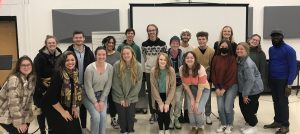
Instead of programming local songs with racist pasts, Vasil and her colleagues recommend looking out into the world and finding ways to include international music in a comprehensive education. To teach her students about world music, Vasil used financial support from the school of music to invite Dr. Juliana Cantarelli Vita, a world music pedagogy expert from Brazil as a guest speaker.
Beyond expanding students’ repertoire, studying international music can also teach students alternate ways of learning the music itself. “[She talked about] how people learn music in other cultures. It’s usually by ear,” Vasil says.
While many American students learn songs through studying sheet music — and sometimes sight-reading — for some pieces, this approach isn’t an honest replication of how the original culture would have learned the song. “How can you get used to doing that? How can you be true to the authentic way that music would’ve been taught, rather than Westernizing it?” Vasil says. “I had her visit many departments throughout the three days that she was here. We reached almost 200 students among different classes.”
The Power of Guest Speakers
Much like the world music speaker from Brazil, many guest speakers are regularly invited to Vasil’s classes to give students a more in-depth education about their areas of specialization. “I was looking at the pockets of my weakness, areas I don’t know as well,” Vasil says.
One of Vasil’s grad students, who goes by the mononym Yeshima and uses the pronouns they/them, specialized in project-based learning, such as learning about environmental consciousness through music. Vasil had them explain how teachers can blend music with other areas of passion.
“It was a great example of how you can guide students to think about things they care about,” Vasil says. “[For example], writing short rap songs with percussion about saving the planet.”
The activity Yeshima led inspired Vasil’s students to compose music about the floods that ravaged Kentucky in 2022. “[They] wrote a little song about the flooding and how they can help,” she says. “Having children engage in that is a big part of DEI work.”
Because DEI is all about making students feel included and understood, Vasil couldn’t ignore the changes — and sometimes even traumas — that some students experienced due to the COVID-19 pandemic.
Help Students Deal with Trauma
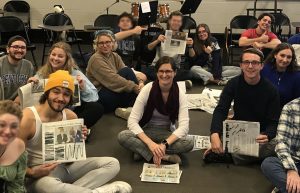
Vasil teamed up with another student, Abigail Van Klompenberg, who taught for 12 years prior to returning to get her doctoral degree, to discuss trauma-informed pedagogy, which is Van Klompenberg’s area of expertise. “She’s been interviewing teachers to understand secondary traumatic stress,” Vasil says. “She’s been reading about practices with children [and] presenting both sides: what you do for your students and how you take care of yourself as a teacher.”
Trauma-informed pedagogy is defined as “identifying the trauma children went through and the stress responses that come out — physical, mental and emotional — and finding ways to mitigate that,” according to the Barnard College website.
According to Vasil, there are many easy ways for teachers to incorporate trauma-informed pedagogy into their regular school day. “For example, having a mindfulness minute at the start of class,” she says. “The kids come in and they sit with you and do a breathing exercise for a minute. At the end of class is quiet listening time. They all lie down and close their eyes, and we listen to a piece of music; we don’t have a set objective.”
Using movement as a form of communication and expression can also engage students who are struggling due to COVID-related trauma. “A lot of trauma is stuck in the body,” Vasil says. Teachers can introduce activities that include movement for expression rather than just sitting down in a chair to play music for the whole period.
As a guest speaker, Vasil’s Ph.D. student also took her undergraduate students through a variety of activities meant to engage students who may be more withdrawn as a result of trauma. “With kids growing up in COVID, they’re having trouble communicating with their peers,” Vasil says. “When they’re in contact with someone else, they find ways to communicate emotions through songwriting.”
Slow Down to Have Big Discussions
For both self-care as a teacher and bringing DEI into the classroom, Vasil recommends slowing down. Big discussions require time for communication and reflection; it’s important not to rush. “We take a whole class period, experience a guest speaker, talk about it, reflect on it, and think about the ways [the students] are seeing that in the classrooms they visit every Friday,” Vasil says.
Overall, Vasil is grateful that DEI has become a bigger discussion at the University of Kentucky, and she’s hopeful that these initiatives will help inspire the next generation of educators. “The students are ready for it,” she says. “They want to be better teachers.”
The University of Kentucky is one of 10 distinguished colleges and universities selected to be part of the inaugural Yamaha Institution of Excellence program, which recognizes extraordinary commitment to innovation in the study of music. The Yamaha Institutions of Excellence were chosen for their dedication to providing unique and challenging experiences to music students through diversity of thought and curriculum. They are also recognized for exposing students to a wider variety of voices and opportunities and preparing them for the modern world of music.









